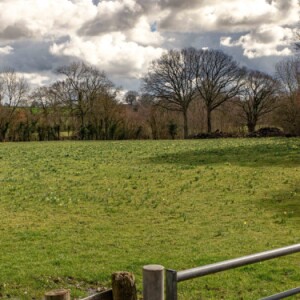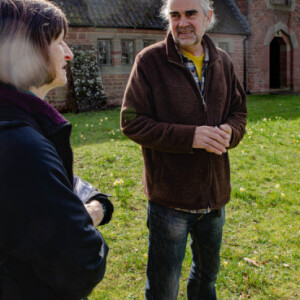Wild daffodils on woodland verge near Kempley
Helena heard about the Kempley Daffodil Weekend being held this weekend in the north of Gloucestershire, close to the border with Herefordshire. It would be a celebration of the wild daffodils found in that area coordinated by ‘DyFRA, the Dymock Forest Rural Action group, which works to maintain the ancient woodland, flora and fauna of the Golden Triangle in north Gloucestershire.’
When I checked their website I wasn't at all surprised to see a photo of one of the coordinators, Chris Bligh, who I’d last seen in 1994 soon after we’d worked together in a London based organisation called Media Nature. Chris has always been a producer and campaigner with environmental organisations.
We drove to Kempley through torrential rain showers, which thankfully cleared by mid-morning just before we arrived. We knew there were walks in the area as well as a 45 minute bus ride around the area to see the profusion of wild daffodils, which survive in certain places where modern agricultural and forestry practices have not prevailed. It is a difficult scenario.
At the village hall we found we’d missed the first bus tour of the day, so we gratefully had coffee and bacon baps to fortify ourselves. I asked one of the many local people providing the wonderful food if they knew Chris Bligh, and was told that his wife was helping out in the kitchen a few yards away. She came out to see us and within a short time we’d arranged to meet Chris briefly at the village church across the road.
It was really good to meet him again even though we only had a few minutes to cover the nearly thirty years since we’d last met. Time enough though to agree to meet again before too long. Chris gave us a quick run down of how he’d come to organise this festival, which I think the website explains, but perhaps without his personally forceful expression of the underlying problems of ensuring their survival.
I grabbed a couple of snaps, of him talking to Helena, and one showing us the tiny wild daffodil shoots in the graveyard. These shoots generally self-seed and then after about four years growth they begin to flower after which they can begin spreading further seeds.
Helena and I had to rush off to get the next mini bus tour with the bonus of a local woman explaining about the varied landscapes we were driving through. The Forestry Commission have planted or replanted many woodlands with coniferous trees in the wider area, seemingly eliminating the swathes of wild daffodils that were formerly always present. They survive in ancient and managed deciduous woodlands as well as on traditionally managed farm pastures. But modern farming methods have eliminated the many small field systems to allow for big machines to have their way, destroying the daffodils’ habitats. A few old pastures do remain and I have added another ‘Extra’ of a field managed as an SSSI (a Site of Special Scientific Interest, where the daffodils are hanging on) and it shows a sense of the landscape as it probably used to be before the twentieth century. Apparently this SSSI meadow was not in great shape.
The old deciduous woodlands have swathes of daffodils in the undergrowth, much like an ancient bluebell woodland that has spread thickly across the ground, all of them benefiting from the abundant light in early springtime before the trees' leaves return. Bluebells may well follow the daffodils, as may wild garlic. The bus stopped for us to walk along a small lane between woodland, much of which was coniferous, where the verges are covered, and in parts the woodland floors were covered with the delightful yellow blooms. – shown in another ‘Extra’. Another ‘Extra’ shows a view over a hedge to where the ‘barren’ modern farmland predominates, looking north-east towards the Malvern hills. The tour guide explained that when she first arrived to live in the area thirty years previously these landscapes were all still small fields with hedges, not the large open grassland covered that have been covered with fertilisers and pesticides.
I’ll leave the ‘Extras’ posted here for some weeks, but I will have to remove them before too long. I hope you get a flavour of the delightful world that Chris Bligh and (most) local people are trying to protect. Apparently there is still a lot of resistance to limiting further damage and repairing the landscape.




Comments
Sign in or get an account to comment.


